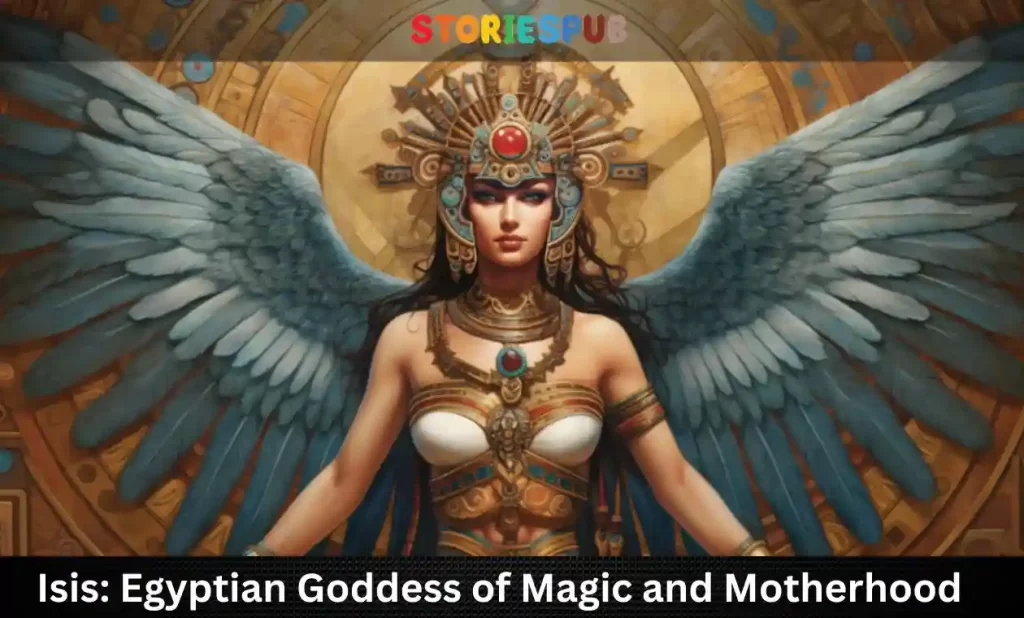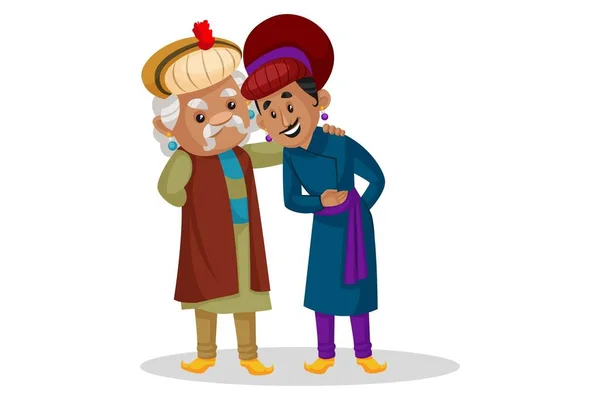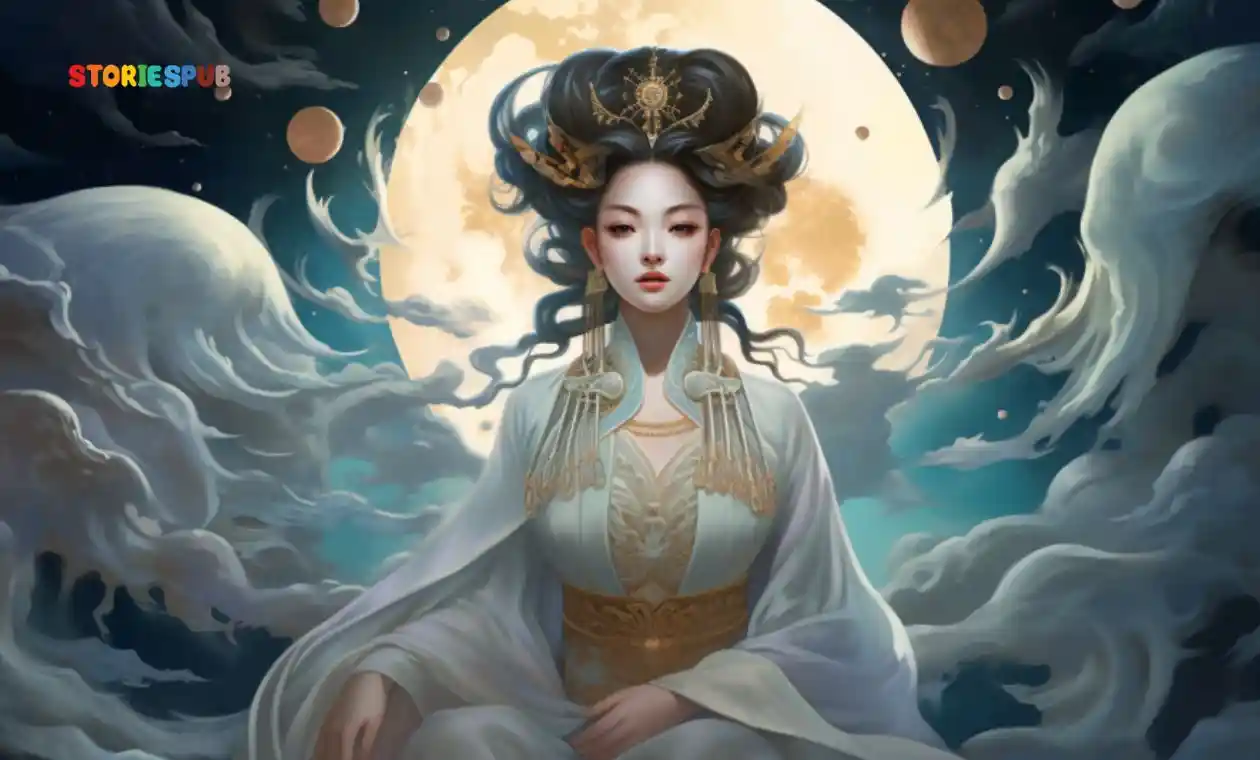Summarize this Article with:
Isis: The Magic and Motherhood of Egypt’s Goddess

The Divine Feminine: Introduction to Isis
Isis, the goddess of fertility, motherhood, and magic, was one of the most worshipped deities in ancient Egyptian mythology. She is often depicted as a beautiful woman with cow horns outstretched on her head, wearing a headdress with a solar disk in between the horns. Her wings are spread out and she is holding ankh (the symbol of life) or a scepter (a symbol of power).
Importance in Ancient Egyptian Mythology
Isis played an essential role in ancient Egyptian mythology. She was considered to be the Queen of Heaven and Earth and the mother of all gods and goddesses.
Her name means “throne” or “seat” which symbolizes her power over all things in existence. As a goddess of fertility and motherhood, she was closely linked to the Nile River which was considered to be the source of life for Egypt.
But Isis wasn’t just revered for her ability to bear children; she also represented magic and wisdom. As such, she was often invoked by individuals seeking healing or protection from harm.
The Story Behind Isis
The story of Isis has been passed down through generations as part of ancient Egyptian mythology. Her story is both fascinating and complex, involving birth, death, betrayal, resurrection – elements that make up some of humanity’s most enduring stories.
The purpose behind telling this story is not only to understand the mythological significance but also what we can learn from it about ourselves as human beings. In this article, we’ll explore each aspect of Isis’ story – from her early years growing up as a young goddess-in-training to her reign alongside Osiris as queen over Egypt; from his tragic death at the hands of Set: God Of Chaos And Evil carrying onto how Isis used her unique magical abilities to bring him back to life once more and, ultimately, how she became the powerful goddess of fertility, motherhood, and magic that we know today.
Isis in Popular Culture
Despite being an ancient deity, Isis continues to be a popular and relevant figure in modern culture. Her image can be seen on everything from clothing to jewelry to home decor. But it’s not just her image that is popular – her story has been retold countless times in books, TV shows, and movies.
One of the most famous depictions of Isis can be seen in Shakespeare’s Antony and Cleopatra where she is mentioned as one of the gods worshipped by Cleopatra. As we dive deeper into Isis’ story, we’ll see why this powerful goddess remains an enduring symbol of fertility, motherhood, magic, strength – a figure who stands out as a beacon for those seeking inspiration in their own lives.
The Relevance Today
The story of Isis has remained relevant because it offers us insight into what it means to be human; both vulnerable and resilient at the same time. Her role highlights the importance of feminine power: fertility as a force for growth; motherhood as a nurturing power; magic as a mysterious yet potent energy.
By exploring the myths surrounding this powerful goddess who embodied all these qualities with grace and strength, we can understand how our own lives are shaped by similar forces. In doing so we might learn something about ourselves that will help us navigate our own unique path through life.
Birth and Childhood of Isis
Creation myth of the world and the gods
In ancient Egyptian mythology, the creation myth begins with the ocean of chaos called Nun. From Nun, a lotus flower emerged, and from that flower came the sun god Atum. Atum created Shu, god of air, and Tefnut, goddess of moisture.
Shu and Tefnut had Geb, god of earth, and Nut, goddess of sky as their children. Geb and Nut eventually gave birth to four children: Osiris, Set (Seth), Nephthys (Nebthet), and Isis.
Isis was born on the third day of the first month in Egypt’s agricultural calendar. Her name means “throne” or “seat,” which could be interpreted as a reference to her role as queen or mother goddess.
Birth and upbringing of Isis
According to legend, Isis was born in secret on an island in the Nile River because her father Geb had been warned that one day she would bear a son who would overthrow him as king. As an infant, she was protected by seven scorpions sent by Ra (the sun god).
Isis grew up living a normal life with her mother Nut until she reached adulthood. She is often depicted wearing a headdress with cow horns because cows were considered symbolic of motherhood in ancient Egyptian culture.
Early Signs of Her Magical Abilities
As a child, Isis showed signs that she possessed powerful magical abilities; in fact, it is said that she was able to speak almost immediately after being born! One early story involves her using magic to help a young boy who had fallen ill; she fashioned a snake out of clay and placed it near his bed so it could heal him when he woke up. Isis’ skills only grew stronger over time, and she eventually became one of the most powerful goddesses in the Egyptian pantheon.
Her magical abilities allowed her to bring the dead back to life, protect women during childbirth, and even control the weather. Isis’ strength and her ability to use magic for good would become a defining characteristic throughout her life, and she would go on to use these powers in many battles against evil forces that threatened her people.
Marriage to Osiris
The story of how they met
According to Egyptian mythology, Isis and Osiris were siblings, born to the god Geb and the goddess Nut. They fell in love at a young age and got married soon after.
Their marriage was seen as symbolic of the union between heaven and earth, as well as of the Nile River’s flooding cycle. Isis was deeply devoted to her husband, who was considered a wise and just ruler.
Together they ruled over Egypt for many years, bringing peace and prosperity to their people. They were greatly loved by the Egyptians for their goodness and wisdom.
Their marriage and reign over Egypt
Isis played an important role in her husband’s reign as Pharaoh of Egypt. She was by his side at all times, advising him on matters of statecraft, diplomacy, agriculture, religion, and warfare. She also used her magical powers to help him rule justly and successfully.
Their reign was characterized by justice, prosperity, piety, artistry, architecture; all areas thrived under their joint leadership. They initiated many reforms that improved the lives of ordinary Egyptians while strengthening Egypt’s economy.
The betrayal by Set and Osiris’ death
Their happiness came to an abrupt end when Set became jealous of Osiris’ popularity among the people. Set conspired against Osiris with a group of evil spirits (the ‘enemies’), tricking him into getting into a coffin that he had made especially for him. After sealing it shut with nails forged from iron from Sirius (Sirius being one place where powerful magic existed), he threw it into the Nile River where it drifted away downstream towards the Mediterranean Sea.
When Isis discovered what had happened she searched tirelessly for her husband’s body along with Nephthys; eventually finding it in Byblos, Lebanon. However, Set found out where she had hidden the body and stole it again, this time cutting it into many pieces and scattering them throughout the land.
Isis then embarked on a quest to retrieve all the parts of Osiris’ body, using her magic skills and the help of other gods like Thoth, Anubis and Horus. After reassembling his body with these magical powers, they performed a ritual that brought Osiris back to life as a god of resurrection, rebirth, fertility.
Search for Osiris’ Body
As the myth goes, Osiris was betrayed by his own brother, Set. He was tricked into entering a coffin which was then sealed and thrown into the Nile river.
The coffin eventually made its way to the Mediterranean where it washed up on the shores of Byblos in Phoenicia. Isis, hearing of her husband’s death, set out to find his body so that she could give him a proper burial.
The Quest to Find Osiris’ Body Parts
Upon her arrival in Byblos, Isis disguised herself as a common woman and began working for the queen. Through her magical powers, she soon gained favor with the queen who entrusted her with caring for her son.
Isis used this opportunity to reveal herself to the queen and request that she be allowed to take possession of Osiris’ coffin. With the coffin in her possession, Isis embarked on a journey back to Egypt with Horus at her side.
Along the way, they encountered various obstacles including a giant scorpion sent by Set to stop them. However, Horus was able to defeat it with his strength and determination.
The Role Played by Anubis, Horus and Thoth in the Search
Upon their return to Egypt, Isis enlisted the help of Anubis – god of embalming – who helped locate all of Osiris’ scattered body parts. Together with Horus and Thoth – god of magic – they managed to retrieve all but one part: his phallus which had been swallowed by a fish. To replace this missing part, Thoth fashioned an artificial phallus out of gold which was magically infused with life force from other gods.
Reassembling Osiris’ Body with Magic
Isis then used her great knowledge of magic and healing to reassemble Osiris’ body, using a combination of embalming techniques and powerful spells. Through her love and devotion, she was able to bring Osiris back to life, though he could no longer reign over the living.
Instead, Osiris became the god of resurrection and rebirth, associated with fertility and the afterlife. He remained a beloved figure in Egyptian mythology and his story continues to inspire fascination and wonder to this day.
Resurrection of Osiris
Isis was not willing to accept the death of her beloved husband, Osiris. She undertook a dangerous journey and searched for his body parts scattered all over Egypt, starting with the Nile Delta.
With the help of Anubis, Thoth, and Horus, she managed to find every body part except one – Osiris’ phallus. The goddess Isis then used her powerful magic to reassemble all the body parts and bring Osiris back to life.
The resurrection ritual that Isis performed was known as “The Rites of Osiris.” The goddess used her magical powers to breathe life back into her husband’s corpse by reciting spells and incantations. This ritual transformed Osiris into an immortal god with powers over fertility, rebirth, and agriculture.
The Importance of Osiris as a God of Resurrection
Osiris is one of the most important gods in ancient Egyptian mythology because he represents resurrection and rebirth. His death and subsequent revival were considered an allegory for the annual flooding of the Nile Delta that brought new life to Egypt’s soil after months of droughts. Egyptians believed that just like how Osiris resurrected from death after being dismembered by Set; crops would also grow in abundance from barren land through natural rejuvenation.
As a god of resurrection, it was said that he could bring both humans and animals back from death if properly invoked through magical rituals. His cult grew in popularity due to his association with fertility which made him even more important for Egyptians who depended on agriculture.
Their Reunion and Conception Of Their Son Horus
After bringing back her husband from death, Isis reunited with him once again during his transformation into an immortal god. Together they gave birth to their son Horus who later became a symbol for kingship in ancient Egypt.
The conception of Horus is a crucial part of this story. After resurrecting Osiris, it was believed that he could no longer have children.
However, Isis managed to conceive a child with Osiris through her magical powers. Horus is thus considered to be both the son of Osiris and Isis, thus having the power of both parents.
The Symbolism behind Horus
Horus became an important figure in ancient Egyptian mythology due to his connection with kingship and protection. The pharaohs of Egypt were considered to be the earthly incarnations of Horus, who was the god of the sky, war, and hunting. Horus was also regarded as a protector deity who fought against Set – the god who had betrayed his father Osiris and killed him.
The battles between Horus and Set symbolized good versus evil – which was a recurring theme in ancient Egyptian mythology. Conclusion:
The story of Isis’s resurrection ritual for Osiris portrays her as an intelligent and powerful goddess capable of utilizing magic to bring back life from death itself. Her love for her husband drove her through all obstacles until she was able to restore him to life permanently by converting him into a powerful god capable of bestowing blessings on his followers.
Moreover, this story highlights why Horus became one of the most important gods in ancient Egyptian mythology because he represented rebirth, renewal and protection against evil forces just like his parents did before him. Overall this mythological tale remains an iconic part of ancient history that still inspires people today because it teaches us that love can conquer even death itself if we believe in magic!
Motherhood and Magic
Isis as a Mother Figure; Nurturing Her Son Horus
Isis was not only the goddess of fertility and motherhood, but she was also a mother herself. After resurrecting her husband Osiris, they had a son named Horus. As a mother, Isis was known for her nurturing and protective nature toward her son.
She taught him magic and wisdom, preparing him to become the next king of Egypt. One of the most famous stories about Isis as a mother figure is when Horus was attacked by Set, his uncle who sought to usurp the throne from him.
In one version of the story, when Set cut out Horus’ eyes during their battle, Isis magically restored them with her powers. This act showed her love for her son and her determination to protect him at all costs.
Her Role as a Goddess Associated with Fertility, Motherhood, Magic, Healing, Wisdom, Protection
Isis’s role as a goddess extended beyond just being a mother figure; she was also associated with various other aspects such as fertility, magic healing wisdom protection among others. As the goddess of fertility and motherhood in ancient Egyptian mythology she represented nurturing energy that promotes growth and abundance in life.
In addition to that , Isis was known for her powerful magical abilities which helped bring back Osiris from death after his murder by Set. Her healing abilities were also widely recognized; she could cure diseases or injuries through spells or potions.
Furthermore ,she was considered wise since she knew how to use magic effectively towards achieving various tasks like bringing back Osiris from death among others . , due to her protective nature towards Horus , it is believed that Isis also offered protection against evils spirits or harm thereby being viewed protector especially during childbirth where women would call upon here for protection
Conclusion
Isis was more than just a goddess of fertility and motherhood. She represented powerful magical abilities, wisdom, healing powers and as a protector against evil forces.
Her important role within Egyptian mythology is widely recognized even today. The stories surrounding Isis continue to fascinate people around the world for her exceptional character traits which we can learn from in our daily lives as parents, protectors or in any other roles we may assume in life.
Hey kids, how much did you like Isis: The Magic and Motherhood of Egypt’s Goddess? Please share your view in the comment box. Also, please share this story with your friends on social media so they can also enjoy it, and for more such Egyptian Mythology, please bookmark storiespub.com.
Related Post :
Isis FAQ
Who is Isis in Egyptian mythology?
Isis is the ancient Egyptian goddess of fertility, motherhood, magic, and healing. She is often depicted as a woman wearing a throne-shaped headdress or with wings, symbolizing her protective nature.
Who are Isis's family members?
Isis is the daughter of Geb (the earth god) and Nut (the sky goddess). She is also the sister and wife of Osiris, the god of the afterlife, and the mother of Horus, the god of the sky. Her siblings include Set, the god of chaos, and Nephthys, the goddess of mourning.
What is the story of Isis and Osiris?
The story of Isis and Osiris is one of the most famous myths in ancient Egyptian mythology. After Osiris is murdered by his brother Set, Isis embarks on a quest to find and resurrect her husband. She gathers the scattered pieces of Osiris's body, uses her magical powers to conceive their son Horus, and raises him in secret to protect him from Set.
How is Isis associated with magic?
Isis is considered a master of magic in Egyptian mythology, using her knowledge and powers to heal, protect, and resurrect her husband Osiris. Her magical abilities made her a popular deity among the ancient Egyptians, who believed she could protect and heal them as well.
What is the significance of Isis's wings?
Isis is often depicted with wings, symbolizing her protective and nurturing nature. Her wings represent her ability to shelter and care for her followers, as well as her divine power to protect them from harm
How was Isis worshiped in ancient Egypt?
Isis was worshiped through prayers, offerings, and rituals in temples and shrines dedicated to her. She had many followers, and her cult spread throughout Egypt and later throughout the Roman Empire. The main temple dedicated to her was on the island of Philae.
Were there any festivals dedicated to Isis?
Yes, ancient Egyptians celebrated several festivals in honor of Isis, including the Lamentations of Isis and Nephthys and the Khoiak Festival. These festivals commemorated the myth of Isis and Osiris and their roles in bringing about regeneration and renewal.
How was Isis depicted in ancient Egyptian art?
In ancient Egyptian art, Isis is typically shown as a woman wearing a headdress in the shape of a throne or with wings. She is sometimes depicted nursing her son Horus, symbolizing her role as a mother and nurturer.
What role does Isis play in the afterlife?
Isis plays an essential role in the afterlife as a protector of the deceased. Along with her sister Nephthys, she is often depicted on coffins, offering protection and guidance to the deceased's soul on its journey through the afterlife.
How has the image of Isis endured over time?
The image and symbolism of Isis have endured and evolved over time, with her cult spreading beyond Egypt during the Greco-Roman period. Today, Isis is still recognized as an iconic figure in ancient Egyptian mythology and is often referenced in modern culture, art, and literature.














